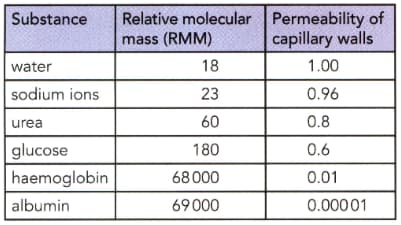Mary Jones, Richard Fosbery, Dennis Taylor and, Jennifer Gregory Solutions for Chapter: Transport in Mammals, Exercise 6: Questions
Mary Jones Biology Solutions for Exercise - Mary Jones, Richard Fosbery, Dennis Taylor and, Jennifer Gregory Solutions for Chapter: Transport in Mammals, Exercise 6: Questions
Attempt the practice questions on Chapter 8: Transport in Mammals, Exercise 6: Questions with hints and solutions to strengthen your understanding. Biology for Cambridge International AS & A Level coursebook 2nd Edition Digital Access solutions are prepared by Experienced Embibe Experts.
Questions from Mary Jones, Richard Fosbery, Dennis Taylor and, Jennifer Gregory Solutions for Chapter: Transport in Mammals, Exercise 6: Questions with Hints & Solutions
The given table shows the relative permeability of the capillary walls in a muscle to different substances.

Use the given information and your knowledge to discuss whether there is a relationship between the RMM of a substance and the permeability of the capillary walls to that substance. If so, how can you explain this relationship.?
The most abundant plasma protein is albumin. Why it is important that the capillary walls are not permeable to this protein?
The disease Kwashiorkor is caused by diet which is very low in protein. The concentration of proteins in blood plasma is much lower than usual. One of the symptoms of Kwashiorkor is the swelling caused by build-up of tissue fluid. Suggest why this is so?
